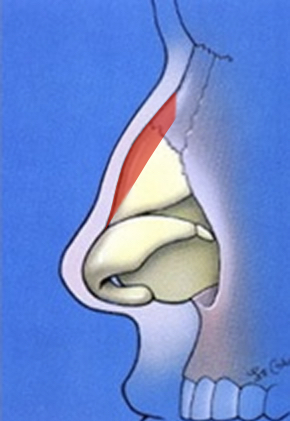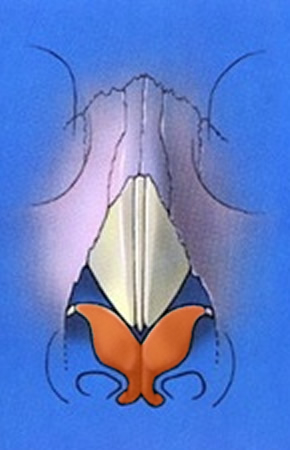Preservation rhinoplasty is one of the latest and most significant trends in the world of cosmetic nose surgery. Surgeons are beginning to favor this type of nose surgery because it involves less excision and less reconstruction, instead relying on refined and advanced surgical techniques that preserve more of the natural structure of the nose.1 San Diego Preservation Rhinoplasty Specialist and leading cosmetic nose surgeon Dr. John Hilinski is one of very few Plastic Surgeons in the U.S. with hands-on training and experience in preservation rhinoplasty techniques.
What is Preservation Rhinoplasty?
Preservation rhinoplasty is a specific approach to reshaping the nose that involves preserving as much (if not all) of your cartilage and bone in the process of accomplishing your aesthetic goals. In other words, preservation rhinoplasty does not involve traditional removal or resection of cartilage and bone that is often done during routine rhinoplasty surgery. Preservation rhinoplasty can deliver are refined and natural-looking. Patients may also experience quicker recovery times with preservation rhinoplasty, compared with traditional rhinoplasty. 2
Preservation Rhinoplasty Vs. Traditional Rhinoplasty
There are several important differences between preservation rhinoplasty and traditional rhinoplasty techniques. While preservation techniques are not the best option for every patient, this type of rhinoplasty offers many benefits to patients who are candidates, including preservation of the bridge, preservation of nasal soft tissue, and preservation of the alar cartilages.
Preservation of the Bridge
 To a great degree, preservation rhinoplasty refers to the management of the nasal bridge and, more specifically, to the treatment of a nasal hump deformity. A nasal hump deformity is also known as a bump on the bridge. This is a very common cosmetic nasal concern that prompts many patients to seek out rhinoplasty surgery.
To a great degree, preservation rhinoplasty refers to the management of the nasal bridge and, more specifically, to the treatment of a nasal hump deformity. A nasal hump deformity is also known as a bump on the bridge. This is a very common cosmetic nasal concern that prompts many patients to seek out rhinoplasty surgery.
Traditionally, when a patient has a large bump on their nose a surgeon will address this by rasping, or sanding, down the bone and cutting the excess cartilage off the bridge. This is shown conceptually in the adjacent diagram where you can see in red the section of the nose that is resected, or cut down by the rhinoplasty surgeon. This classically involves use of a surgical rasp to sand down the bone followed by cutting of the cartilage (the white shaded area in the diagram) to bring the bridge height down. By sanding down the bony hump and resecting the cartilage, the surgeon is able to achieve a straighter side profile view of the nose.
Unfortunately, when this particular surgical technique is used to reduce a nasal hump deformity, there is a significant amount of disruption to the native framework of the nose, which can destabilize the structure of the nose. This only makes sense since we are literally resecting, or removing, a good portion of the bone and cartilage in an attempt to reduce the size of the nose. Once the bone and cartilage are removed, the surgeon has to do something during surgery in order to restore adequate, proper support of the remaining bridge. In fact, taking a hump down using this technique triggers a whole sequence of necessary steps that need to be taken in order to make the nose stable in the long run. And each step introduces more and more variables that can lead to potential abnormal healing. In turn, each of these increases the chances of postoperative cosmetic irregularities with the nose. Do all patients develop cosmetic problems after hump reduction rhinoplasty surgery? No, but studies show that almost 10% of rhinoplasty patients seek revision surgery, which could be avoided by using preservation rhinoplasty techniques.3
So what if we could effectively avoid having to deal with these issues altogether by preserving the nasal bone and cartilage – while still being able to lower the height of the nasal bridge? Well, we can! That is precisely what preservation rhinoplasty allows Dr. Hilinski to do – preserve the natural bone and cartilage in the process of lowering the nasal bridge height. This can be done using highly specialized surgical technique that involves making incisions deep within the nose rather than cutting the tissue overlying the bridge. By carefully and strategically removing certain segments of cartilage and bone inside of the nose, room is created so that the nasal bridge can drop down or be pushed down to the desired new location – thus lowering the bridge and getting rid of the hump deformity. By preserving the overlying bone and cartilage, the natural contour of the nasal bridge is maintained and less variables are introduced into the healing process. With less variables involved, there is less risk of patients having contour irregularities as the nose heals. In fact, the nasal bridge can look so much smoother and natural following preservation rhinoplasty surgery.
Preservation of Nasal Soft Tissue
Preservation rhinoplasty also implies that the surgeon is saving most of, if not all, the nasal soft tissue. More specifically, this involves preservation of what are called the soft tissue envelope and nasal ligaments. The soft tissue envelope essentially refers to the skin and subcutaneous tissue that cover the framework of the nose. The nasal ligaments are dense, fibrous bands inside of the nose (like rubber bands) that keep various types of tissue attached to one another – including the soft tissue envelope to the deeper cartilage. In classic rhinoplasty surgery, there may be little regard paid to preserving the true layers of the soft tissue envelope and nasal ligaments. If these important structures are damaged or destroyed during rhinoplasty surgery, it can lead to unwanted consequences in terms of the shape of the nose – which, in turn, can ultimately result in the need for a revision rhinoplasty surgery. Dr. Hiliniski has found that making the extra effort to preserve the soft tissue envelope and nasal ligaments results in a much more predictable outcome with less risk of postoperative complications.
Preservation of the Alar Cartilages
 The other significant aspect of preservation rhinoplasty involves saving the alar cartilages as much as possible. The alar cartilages are the cartilage segments that comprise the nasal tip, as is shown in the adjacent diagram in the shaded orange color.
The other significant aspect of preservation rhinoplasty involves saving the alar cartilages as much as possible. The alar cartilages are the cartilage segments that comprise the nasal tip, as is shown in the adjacent diagram in the shaded orange color.
In so many cases of cosmetic rhinoplasty, the nasal tip cartilages are resected, or cut, to try and reshape the tip of the nose. For example, in patients who have a bulbous nasal tip deformity, rhinoplasty surgeons will often cut out certain portions of the alar cartilage in an attempt to make the nasal tip look more narrow or defined. The thought here is that the nasal tip has too much cartilage volume – so removing some of the alar cartilage will make the tip look smaller in size. Unfortunately, in many of these cases, this technique of alar cartilage resection will result in unpredictable contour changes and scarring that lead to increased risk of having to undergo revision rhinoplasty.
In recent years, many alternative techniques have been popularized that do not involve removal of the alar cartilages of the nasal tip. In terms of preservation rhinoplasty, these all involve an effort to preserve the entirety of the lower alar cartilages. In some cases this may involve incising, or cutting, the alar cartilages – but none of the cartilage is actually removed from the nose. Instead, it is preserved and simply moved around in an attempt to make the nasal tip look more defined and refined. In doing so, the rhinoplasty surgeon is not compromising the support of the nasal tip because all of the structure is being preserved. Preservation of the alar cartilage also helps to minimize unwanted, unpredictable changes that would otherwise occur during the healing process. Therefore, the risk of having to undergo revision surgery is much less with preservation rhinoplasty surgery.
Am I a Candidate for Preservation Rhinoplasty?
If you would like to change the look of your nose and you would like natural-looking results, then preservation rhinoplasty may be right for you. Ideal candidates for preservation rhinoplasty have not had prior nose surgeries and are seeking to reduce the appearance of a bump or shorten the projection of their nose.
Learn More About Preservation Rhinoplasty in San Diego
The best way to learn more and decide if preservation rhinoplasty is right for you is to schedule a consultation appointment with Dr. Hilinski at his San Diego office. Dr. Hilinski is Board Certified by the American Board of Otolaryngology (ABO) and the American Board of Facial Plastic and Reconstructive Surgery (ABFPRS) and he is widely regarded as a leading expert in rhinoplasty. Contact us today with any questions or to schedule your consultation.
References
1 Rollin K Daniel, The Preservation Rhinoplasty: A New Rhinoplasty Revolution, Aesthetic Surgery Journal, Volume 38, Issue 2, February 2018, Pages 228–229, https://doi.org/10.1093/asj/sjx258
2 Charles East. Preservation rhinoplasty. ENT & AUDIOLOGY NEWS VOLUME 28 ISSUE 3 JUL/AUG 2019
3 Kosins AM, Daniel RK. Decision Making in Preservation Rhinoplasty: A 100 Case Series With One-Year Follow-Up. Aesthet Surg J. 2020 Jan 1;40(1):34-48. doi: 10.1093/asj/sjz107.
Dr. John Hilinski has either authored or reviewed and approved this content.


